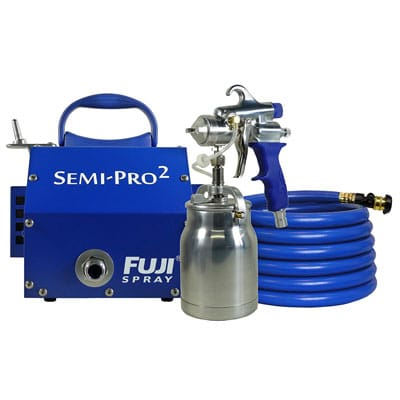So you finally took the step up from the average painter to the professional hobbyist by getting your hands on a Fuji paint sprayer?
Nice one!
Switching from brushes and rollers to a sprayer is a no-brainer for paint enthusiasts.
We are big fans of the Fuji 2202 and the Fuji 2804-T75G Mini-Mite but unfortunately, sprayers have a tendency to do something that brushes don’t…
They get CLOGGED.
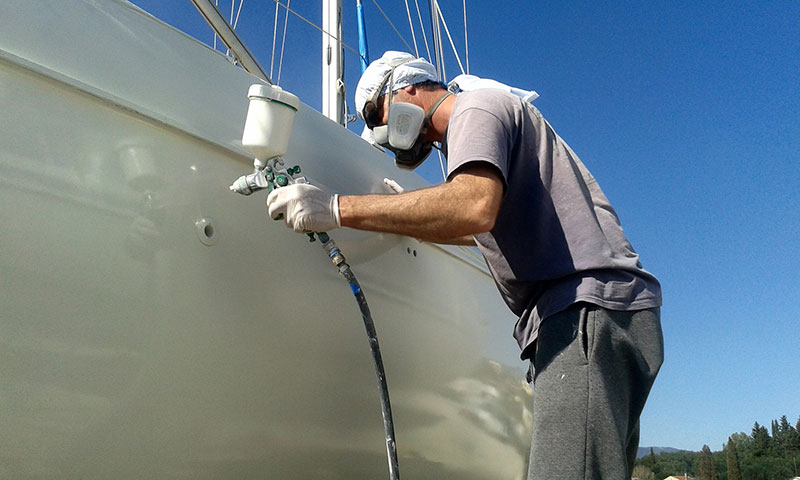
Why you want to avoid clogs.
Let’s face it, nothing is more frustrating than finally carving out the time to dedicate to that DIY project only to be held back by an equipment malfunction like a clog.
Clogs can impact your painting in a number of ways:
- Wastes precious time that could have been spent painting.
- Wastes money spent on replacing parts.
- Wastes energy and effort trying to deal with them.
- It can reduce the quality of the overall job.
A clogged up sprayer can really put a damper on your painting project.
That’s why we have put together this quick post on how to figure out what’s wrong and how to fix it fast – so you can get back to painting ASAP.
How to Fix Your Clogged Up Fuji Paint Sprayer
How do clogs occur?
Clogs can occur in your Fuji paint system due to a variety of reasons. Sometimes it is just one of these reasons, sometimes even all three.
Dry paint.
The most obvious cause is paint drying up and causing a blockage in part of your Fuji paint sprayer.
Latex paint is especially notorious for causing clogs, not just in paint sprayers. In fact, there have been several cases where apartments have been flooded due to latex clogging the drains after a painter washed out latex painting supplies in a bath tub!
Debris.
Just about anything can get into your fuji paint sprayer and clog it up. The most common types of materials are:
- Blades of grass.
- Dust.
- Dirt.
- Fine gravel.
Paint is too thick.
Sometimes the paint you use can actually be too thick to run through the system. This is where paint thinning comes in.
When thinning, it is recommended to use a thinner that matches the paint you are using. Usually, the safest way of doing this is to buy the same brand.
However, a lot will rely on trial and error. It is wise to play around with various settings and consistencies in order to achieve the best result.
When purchasing your paint and thinner don’t be afraid to mention the model of your Fuji paint sprayer to ensure that it is compatible.
Not all products will require thinning but it is an important thing to keep in mind.
Your sprayer isn’t compatible with the paint.
Your model may have a hard time spraying lacquer due to its fast drying properties. Those of you who have a turbine motor may have trouble with lacquer as the heat from the turbine can cause it to dry faster and actually cause peeling.
There are ways around this such as applying extremely thin coats at a time, but more likely than not it would be suggested to use a different paint sprayer more suited to lacquer.
A word of caution on lacquer: spraying lacquer may actually be prohibited in your area. Always be sure to check with local regulation.
If you are spraying lacquer be sure to take the necessary safety precautions as it can be highly toxic and flammable.
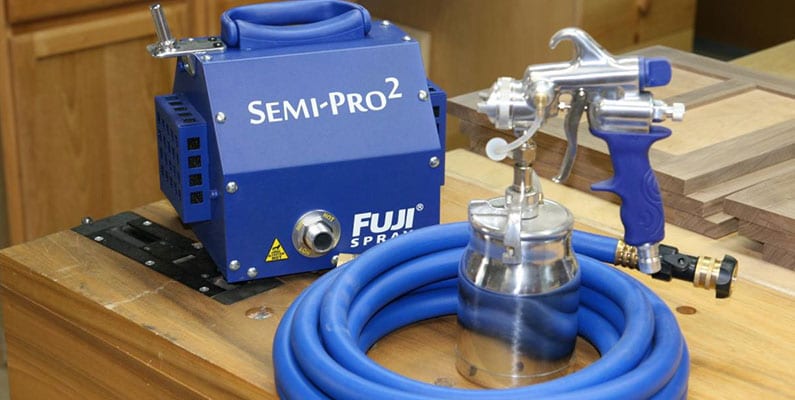
How can you tell if your Fuji paint sprayer is clogged?
There are some pretty common tell-tale signs if a clog is causing your painting problems:
- Inconsistent spray pattern.
- Weak spray power.
- Paint not coming out at all.
When any of these problems occur the first culprit you should suspect is a clog. Thankfully they are usually pretty easy to deal with.
How to unclog a Fuji paint sprayer.
There are a few different types of clogs that can stop the paint from hitting those walls:
- Spray tip clog.
- Tube clog.
- Check valve clog.
Depending on what type of clog you have will lead to the best course of action to get you back to work.
Dealing with a spray tip clog.
What is it?
A spray tip clog is when a blockage occurs at the paint exit point of your Fuji paint sprayer.
This is the easiest place to spot and requires the least effort of all the clogs to eradicate.
Clearing the clog.
You should be wearing safety glasses and gloves at all times when operating a sprayer but it is particularly important that you do so when clearing a clog.
Be sure to turn the sprayer off so you don’t spray yourself!
Take a quick look at the spray tip and see if there is anything blocking it, if not then we suggest unscrewing the air cap to get a better inspection.
After removing the air cap and the and the collar you will be able to fully see the spray tip. By carefully using a pipe cleaner or a wooden toothpick you can successfully dislodge anything that may be causing the blockage.
We recommend using very little pressure in order not to cause any damage. If something is indeed severely stuck, exercise caution when trying to remove it.
If you can’t remove the blockage from the outside running solvent through the sprayer may help push it out from the other side.
If these options fail then you should replace the part.
Replacing the part.
Sometimes a severe block or a worn out spray tip can leave you with no other option except to replace the part.
Following the user manual of your specific model will show you how to disassemble your current sprayer and reassemble it with the new part.
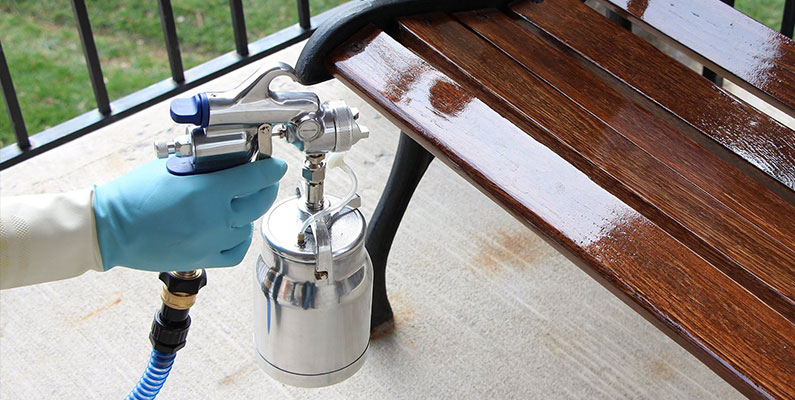
Dealing with a tube clog.
What is it?
On a Fuji paint sprayer, there are multiple points where the tube could clog. Most pressure problems are related to the tube so it’s a great place to check for a blockage.
Thankfully the tube is transparent making it incredibly easy to spot any problems.
Clearing the clog.
- Remove all filters and valves from the tube.
- Run solution through the tube and clean gently with a pipe cleaner if necessary.
- Always double check that the nipple attachments at both ends are completely open.
- Exercise extreme caution not to cause any damage to the tube as any scratches will become a magnet for paint to latch into and dry.
- Be careful not to make a hole in the tube of any size as this will render your tube completely useless.
Replacing the part.
Tubes are relatively inexpensive and are very easy to replace. If there are any visible defects in your tube it would be advisable to get a replacement right away to ensure that no further complications arise.
Dealing with a check valve clog.
What is it?
The Fuji industrial spray check valve is a one-way check valve featuring a convenient duckbill design.
Basically, the check valve prevents paint from backing up in the wrong direction.
This leads to a considerable amount of pressure being exerted against the valve at various times making it a quickly wearing part and prone to clogging.
Clearing the clog.
If clogged, the check valve cannot be taken apart but you can clear any blockage by soaking in thinner for up to 30 minutes.
A small wooden toothpick could be utilized to remove any really stuck material.
Replacing the part.
You can actually buy a 5 pack of tubes and check valves for a great price, so even if you don’t have any problems with them right now they are a cheap investment to have as a backup.
Due to the inexpensive nature of check valves, many people would rather replace them instead of cleaning them. This certainly can save time if you are under pressure to complete a job but is entirely up to you.
When it’s not a clog.
If you have tried all of the above steps then the chances are that a clog might not be your problem.
There are a few other factors that may lead to paint not coming out the nozzle:
- Air leaks in the hose.
- The cup lid not being on tight enough.
- Needle packing may be too tight preventing the needle from effectively moving.
Be sure to check out the user manual of your device for more thorough information.
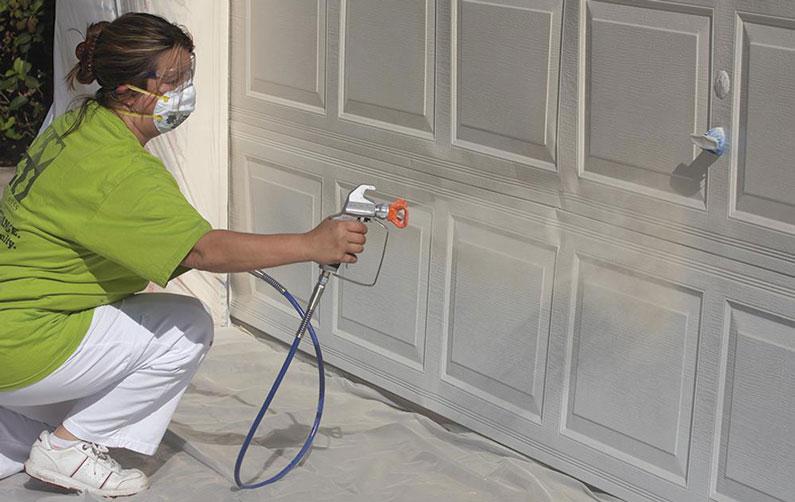
Preventing clogs.
Unclogging a Fuji paint sprayer can take time and effort. Benjamin Franklin is famous for saying “an ounce of prevention is worth a pound of cure,” a truth that can still be applied today.
The best option is to prevent the clogs in the first place so you don’t have to deal with them.
Here are a few tips to help keep those clogs away so you can keep on spraying!
Improve you cleaning methods.
- Empty all paint from the cup and wipe it clean with a rag.
- Spray a cleaning solvent through the gun.
- Repeat until the spray is coming out clear.
- Do this before the paint dries.
- Don’t soak the spray gun in a solvent as it can remove grease and cause damage.
- Be aware not to cause damage while cleaning by using a wire brush, instead use a soft rag.
- Regularly lubricating the machine can help improve its longevity.
Do not disassemble the cup even for cleaning as the threads have been factory sealed to prevent leakage.
Cleaning should be carried out at the end of every session. Be careful taking long breaks in between coats as some paints dry faster than others which could leave you with a dried up sprayer.
Periodically it is wise to disassemble the sprayer and give it a deep clean. Fuji paint sprayers have a lot of exposed metal which can be easily corroded so cleanliness is essential to prevent this.
Storage:
You shouldn’t store your Fuji paint sprayer with any liquids inside as this can lead to problems.
Be sure to keep the sprayer in a safe and secure place, especially when in transit so that no damage can occur.
Don’t leave your spray in a sealed box or contained area as moisture could build up – especially in areas of humidity.
An open space where air can get at your Fiji sprayer is ideal so that it can thoroughly dry.
Keep your sprayer away from extreme temperatures both hot and cold.
Replacements:
You can only prevent issues for so long, eventually, you will have the replace parts after excessive use.
Fuji paint sprayer parts can be purchased online.
Choosing the best tool for the job.
A Fuji paint sprayer is a great amateur tool for those small DIY projects.
However, if you find you are taking on bigger jobs and using it more frequently you may want to consider upgrading to a heavier duty sprayer that can take on a larger workload and get the job done faster.
We at Tool Nerds are paint sprayer experts. We review a wide range of sprayers so that you can make an informed decision and choose the best sprayer for the job.
Check out some of our favorite paint sprayers here.
Should you require any more assistance when it comes to choosing a paint sprayer feel free to contact us.
Thanks so much for reading this post. We hope you found it useful!
